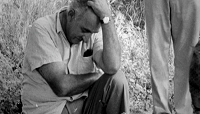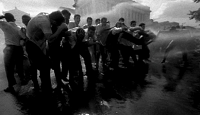I Am Cuba, the Siberian Mammoth
04/29/2012
Brazil / 2005 / Spanish, Portuguese & Russian
Directed by Vicente Ferraz
 In 1960, a crew of Soviet filmmakers, led by director Mikhail Kalatozov and cinematographer Sergei Urusevsky, came to Cuba to produce a film about the revolution there, from the lavish inequality that spurred it on, to the brutal tyranny that quashed it time and again before it finally rose up from the hills. The product of this sojourn, I Am Cuba (1963), is, not surprisingly, a slick and Soviet-ized dramatization of life on the island nation, rendering real events and slices of life with the effortless plasticity and blinding luster that is familiar to anyone who has seen The Cranes Are Flying (1957) or The Letter that Was Never Sent (1959). A film of technical brilliance whose tantalizing visual puzzles still beckon, I Am Cuba also presents a mystery all the more remote because of its nearly 30-year hibernation, out of sight for all, and seemingly out of mind for nearly as many.
In 1960, a crew of Soviet filmmakers, led by director Mikhail Kalatozov and cinematographer Sergei Urusevsky, came to Cuba to produce a film about the revolution there, from the lavish inequality that spurred it on, to the brutal tyranny that quashed it time and again before it finally rose up from the hills. The product of this sojourn, I Am Cuba (1963), is, not surprisingly, a slick and Soviet-ized dramatization of life on the island nation, rendering real events and slices of life with the effortless plasticity and blinding luster that is familiar to anyone who has seen The Cranes Are Flying (1957) or The Letter that Was Never Sent (1959). A film of technical brilliance whose tantalizing visual puzzles still beckon, I Am Cuba also presents a mystery all the more remote because of its nearly 30-year hibernation, out of sight for all, and seemingly out of mind for nearly as many.
Actor Sergio Corrieri recalls the iconic scene of the student’s funeral procession in the film, as people course through the winding streets to follow his wreathed casket. He looks surprised, however, when told that he himself appears in that scene. I Am Cuba seems to hold out in much the same way for many of those involved in its production – a powerful and life-changing experience from out of left field that nonetheless fades dramatically from their minds, as if willed away or pushed aside by a burgeoning sense of national identity. Throughout his documentary I Am Cuba, the Siberian Mammoth, Brazilian filmmaker Vicente Ferraz attempts to trace this elusive presence through the lives of the surviving cast and crew, to extract the vestiges of its influence into the modern era. The result is at once historical, vividly examining the conditions under which the film was made, and critical in its analysis of what made it troublesome in its day – perhaps the very qualities that caused it to be celebrated upon its revival in the early 1990s.
The recollections in the documentary are far from perfect, and that slippery element gives them a texture that Ferraz uses to negotiate the layered realities contained in the scenes themselves. For the film is a phantasm, a chimera in more ways than one, and he chooses footage from its many ghostly passages to retain and examine that effect. Pockmarked by the vagaries of memory, the story of the production film and its clouded aura are all the more hallucinatory when set next to the icy blast of the film itself, the raw urgency of its recreations and the mythic quality of its historical sculpting.

I Am Cuba (1963)
I Am Cuba is held forth as Kalatozov and Urusevsky’s magnum opus, which must have made its critical upbraiding and almost immediate burial more than a little disheartening for them. They spent nearly two years of their lives filming it, working with a dedicated crew and a cast of thousands. While Ferraz demonstrates a great deal of reverence for the film, he also sees the importance of contextualizing it in the time and environment in which it was made, using his interview subjects to help shed some light on why it was so widely repudiated. The interview subjects who worked on the film – carpenters, production secretaries, actors – have the locals’ understanding of why it was damned from the very start. Not all of them dislike the film, and aside from the odd dialectical quibble, there aren’t many big complaints about it. They remember the visiting Russian artists with much admiration, and look back on the shared ordeal of making the film rather fondly.
While European filmmakers such as Varda, Godard, Ivens and Zavattini poured into Cuba to document what was going on there in the 1960s, they and the Soviets did not exert much influence on their Cuban counterparts. There, it seems filmmakers were being more influenced by Brazil’s Cinema Novo movement as a model for cinematic modernism, its vivacity and poverty as inspiring as its uncompromising political engagement. For Cuban audiences, the “social realism” of Soviet films was not real or social enough – the massive edifices of the characters’ faces hurled upward across the screen, the spatial protraction and temporal deceleration were utterly foreign. The truths were considered too sparse and taking an impossibly long time to materialize. Blame Eisenstien. To boot, Alea had already retold the story of the revolution (to much wider acclaim than Kalatozov’s film had), thereby inaugurating the ICAIC. On the other side of I Am Cuba‘s release map, Soviet audiences (or perhaps just Soviet censors – it is unclear) were uninterested in its depictions of decadence and capitalist misery. After a short and quiet run, its two existing prints – one in Cuba, one in the Soviet Union – were both shelved.
Composer Carlos Fariñas recalls Kalatozov coming to him with footage of a photogenic old man with a guitar on the street corner, and asking him to record a song to use in place of the old man’s atonal rambling. At another time, Kalatozov ordered the carpenters working on the production to use wood to redirect the path of a waterfall so the light would hit it just right in the shot. They were taken aback, but set about doing it. This impulse to stylize and idealize, to turn the complexity of the revolution into art, is paradoxically what made the film a failure in the eyes of so many. While shoring up the film’s status as a remarkable artistic and technical achievement, Ferraz also portrays it as an unwieldy creature that tramped up and down the island on indelicate feet, a Soviet vision of a tropical revolution that was unconcerned with life as it was there. So the film found itself in a peculiarly landless position, a beautiful and untouchable contrivance that got no attention on the neorealist-loving shores of Cuba, nor the decadence-hating circles of the 1960s U.S.S.R.
 The title of Ferraz’s film – and his characterization of the filmmakers as mammoth personalities – comes from a quotation from J. Hoberman, written at the time of the film’s revival in the early 1990s. I Am Cuba came back into the light unexpectedly, as something dormant and long unknown could only do, massive and fully-formed, like an exhumed skeleton from beneath the permafrost. Its vitality, immediacy, and importance are perfectly preserved, not in the least bit corroded by time. Since its discovery and reappraisal, there seems to be little besides glowing praise for the film, perhaps because it is now separated from its problematic inception and politically sticky context, thereby taking its place as a stunning, innovative, and haunting epic that stands apart, utterly unique from other such projects done in Cuba in the days following the revolution.
The title of Ferraz’s film – and his characterization of the filmmakers as mammoth personalities – comes from a quotation from J. Hoberman, written at the time of the film’s revival in the early 1990s. I Am Cuba came back into the light unexpectedly, as something dormant and long unknown could only do, massive and fully-formed, like an exhumed skeleton from beneath the permafrost. Its vitality, immediacy, and importance are perfectly preserved, not in the least bit corroded by time. Since its discovery and reappraisal, there seems to be little besides glowing praise for the film, perhaps because it is now separated from its problematic inception and politically sticky context, thereby taking its place as a stunning, innovative, and haunting epic that stands apart, utterly unique from other such projects done in Cuba in the days following the revolution.
The focus is predominantly on a Cuban perspective, with a few interviews with Russian people added to round it out. This saves it from falling into too much speculation, and keeps things feeling pertinent to the period being discussed. It is concerned with the place and the people involved with the film who are still around, its three main creators (Kalatozov, Urusevsky, and assistant director Belka Fridman) having all passed away long before the film’s rediscovery. With its lyrical shots of Cuba in the 21st Century, all of it being mirrored with that of yesteryear in what is essentially a foreign film about the country itself, the experience is a perplexing one to say the least.
What emerges is a portrait of a place that wanted to assimilate aspects of the outside world selectively. A Cuban photographer who worked on the film talks about how they did not think much of it when it was made, but wound up making many films with Soviet equipment, some of the same cameras used by Urusevsky, and perhaps unknowingly absorbed a lot of the technique that was transplanted there by the film’s production. Its influence, in other words, was subtle but, ultimately, far-reaching.

I Am Cuba (1963)
That none of the Cubans involved whom Ferraz tracked down seem to have had any knowledge of its revival and acclaim (more than ten years after that happened), says a lot about how highly regarded the ‘world cinema’ scene is in Cuba. As far as they are concerned, the film is a foreign product, and this is a country that has long been wary of imports. The feeling is a bit split between fondly remembering Kalatozov and his people, and avoiding acknowledging the technically advanced Soviets as mentors. Important Cuban filmmakers such as Alea, Sara Gómez and Julio García Espinosa had little interest in taking on a foreign way of seeing to depict their country. But perhaps they did, without realizing it, using foreign cameras and techniques introduced by the Soviets.
Kalatozov’s film leaves behind a great many questions, like a receding tidal wave peppering the landscape with strange fauna, some of which refuse answers, their conditions lost to the memories of those involved. Shots that appear handheld until the camera floats downward from beneath a balcony, or crawls steadily across third-story windows, defy rational explanation. The silver nitrate’s solar luminosity is explained in a technical way, but the conceiving of it by Urusevsky (a consummate visualizer who spent hours blindfolded so as to see the most light when it came time for filming) cannot be. I Am Cuba was a dream of its creators, far from a sober actuality, and perhaps it needed to resurface after thirty years to even begin to be decoded.
As a work of art, I Am Cuba is not without problems. Nonetheless, and as the recollections collected in Ferraz’s film attest, it is so much more than a misguided attempt to capture the spirit of a particular historical moment. Its accuracy in doing so – or, more appropriately, its truthfulness – can be measured in the complete story, behind the scenes and beyond its time, past the lives of those who made it. The intent behind it, its reception and lasting thrall – these things say more about what made the Cuban revolution unique and important than the film’s content is able to do. So even a film made through Soviet eyes, through Soviet lenses, and having the gall to be called I Am Cuba, does ultimately have an inherently Cuban story to tell.
